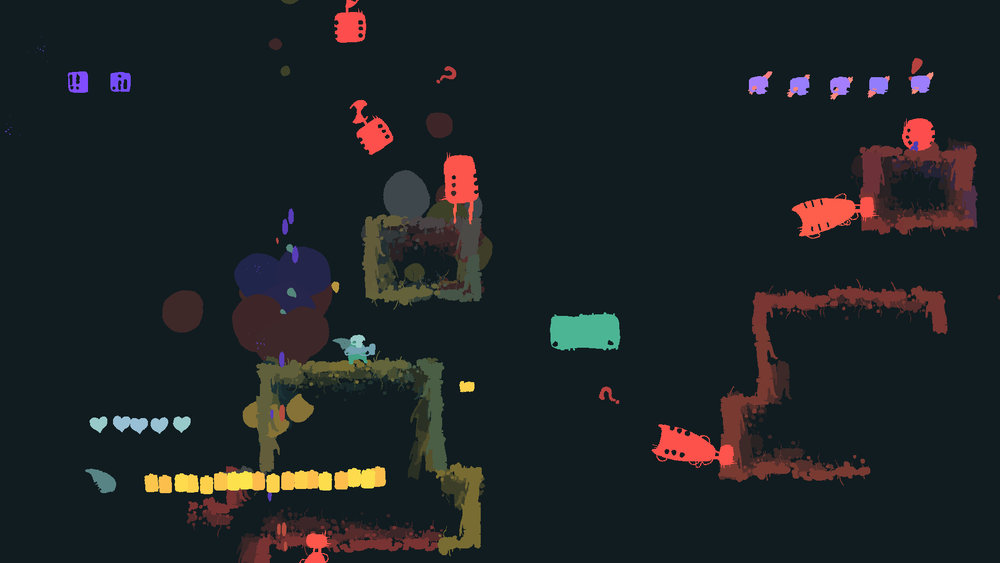Nothing Ventured, Nothing Gained
Players gain a new type of passive interaction when playing games with a lexicon that’s foreign to the rules we abide by in everyday life. In turn, this forces the player to identify affordances, one of the core building blocks of modern design.

Every game has an inherent lexicon, not of words necessarily but of “design language”; a set of rules and systems that govern the world the player inhabits. While the real world has things like the laws of physics, skeuomorphism, and internationally recognized symbology, there are games out there that have very little in common with our reality. When one of these games brings a new player into an unfamiliar world, the first challenge presented is deciphering its lexicon. While games vary wildly in environment, from ancient civilizations to alien planets, their languages typically exist in a context analogous to our own. Objects and relations are familiar, or at least presented in a familiar manner. But what happens when the analogy is lost? When a game takes place in a world that is not only unlike our own, but we have no apparent way of familiarizing it? Games that fall under this category can be uniquely effective in teaching players about storytelling and game design, and playing them should be a regular activity for those interested in better understanding how games work. Without an explicit prompt, players will find themselves taking notice of things normally taken for granted: Do characters in this world communicate in a way we recognize as language (Journey, for example)? Are objects recognizable or do they subscribe to familiar design patterns? Do characters fit in with our biology and evolution, or does their design imply this world is in a distant or parallel universe?

When a game is intentionally designed to require the player to devise their own context and instruction, it introduces another level of interaction and connection. When a player is forced to connect the dots on their own, the lines they draw become instrumental to their experience, and by creating and sharing these experiences, communities are given greater opportunity to collaborate and build personal connections. Additionally, because a greater percentage of these experiences are organic, players are naturally more drawn to elements they’ve created on their own.
While the exercise of familiarizing and extending an unknown lexicon is inherently positive (practices creativity and adaptation to new environments), there is an added bonus for those who express interest in game design or are designers themselves: improving your ability to identify affordances. Affordances are present in nearly every game where designers need to define objects in an environment where a more direct approach would be inappropriate or impossible. As the player creates organic elements through deep understanding, they begin to recognize how the affordances they’ve inevitably created supplement specific areas of the game that benefit from these distinct contributions. By understanding affordances, you add an invaluable skill to your repertoire of design talents; because affordances are used for direction, progression, and even instruction, you begin to understand how to design around metaphors and subtleties, rather than obvious tutorials or storytelling. Affordances are present in every aspect of development, from art assets to player mechanics, and their underlying design doesn’t change much despite being wildly varied in execution. Designing an NPC behavior to guide the player from Point A to Point B may have the same end result as designing a funnel-shaped level, but the work that goes into either approach is completely different. It’s important to ask yourself: Where is the affordance, what options did the designers have to achieve the same effect, and why did they go with this approach?

GoNNER, a 2D roguelike platformer by Art in Heart, is a great example of a familiar world with a mysterious lexicon. We’re all familiar with platformers, and increasingly comfortable with roguelikes in recent years, however, the abstract and stunning world featured in GoNNER is hugely unique. WIth no instruction or direction, the player is expected to progress through a dark and abstract world, where their motives, abilities, and even identities are unclear. This world interestingly enough is inhabited by a combination of familiar animals, recognizable demonic beings, and death itself, all peacefully coexisting (which introduces a creative affordance, in which the player creates an identity for the “protagonist” based on their behavior). While there is a basic story to the game, it plays a minimal role in the actual gameplay, and isn’t evident based on gameplay alone. As the player seemingly creates the world while they explore it, abstract colored shapes come together to form floors, walls, and platforms with quiet but distinct “wooden board” sounds (a conceptual affordance, associating these shapes with wood reminds the player of other common surfaces made of wood in real life). Additionally, the player is rewarded small purple glyphs upon killing multiple enemies, which seemingly represent an unknown alphabet, presumably for the unintelligible audible language used within the game. Even as the game begins, the player has no discernible features and must acquire a head, weapon, and wearable item before progressing. In a mysterious and abstract world, a player begins without an identity, a language, a past, or a future. It’s what the player does that creates it, bringing a cryptic lexicon into the realm of the relatable.
Lastly, for those of us who neither design games nor think to deeply about them, playing a game with an unfamiliar lexicon is a great step toward understanding games at a more granular level and from a designer’s standpoint. Not only do you get a close look at how many working parts of a game interact, but you also get an opportunity to identify affordances and build on them; directly contributing to the player experience. With a strong enough community, you’re able to share your work and discoveries with your peers and get their thoughts and feedback, granting yourself an opportunity to grow as a gamer and creator alike.
Read more about:
BlogsAbout the Author
You May Also Like









